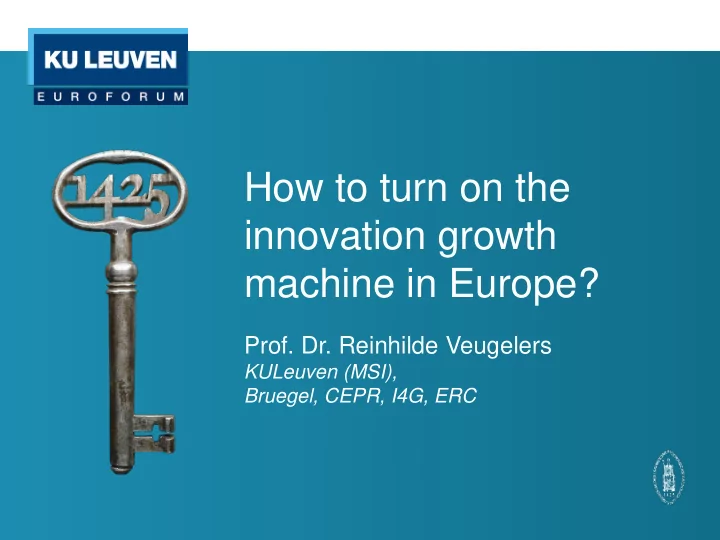

How to turn on the innovation growth machine in Europe? Prof. Dr. Reinhilde Veugelers KULeuven (MSI), Bruegel, CEPR, I4G, ERC
Outline • Europe’s Deficit in Innovation Performance o Europe’s Persistent Business R&D Deficit as a symptom, rather than a cause • Europe’s Persistent Business R&D Performance Deficit Related to Age & Sector Composition Effects: o Missing Yollies in Innovation based Growth sectors • Barriers for Yollies in Innovation-based Growth sectors in Europe • Recommendations for Innovation-Based Growth Policy Making in Europe
Diagnosing EU’s innovation deficit Europe’s gap relative to the US holds across almost all components of innovation capacity (systemic deficit) There is substantial and persistent heterogeneity in innovation potential across EU countries Persistent Business R&D EU-US gap
Diagnosing EU’s private R&D deficit • The nature of EU’s industrial structure is a major reason for the persistent business R&D investment deficit: a deficit in the capacity for creative destruction EU is specialized in « ollies » in medium-tech sectors, o EU misses « yollies » in new high-tech, high-growth sectors o Innovation Based Growth Sectors : sectors which (i) have an R&D intensity above average, (ii) an R&D growth rate above average and/or (iii) an above average share of young companies among its leading innovators. aerospace, biotech, computer hardware&services, health care equipment & services, internet, pharmaceuticals, semiconductors, software, telecom equipment . Yollies : companies born since 1975 who have made it into the R&D scoreboard of world leading innovators Amazon, Google, Microsoft, Qualcomm, Amgen…
W hat the US has but the EU lacks: Yollies Share of Yollies in number of World Leading Innovators, their R&D, sales and employment by region (2007) (in %) Europe US Japan World Number of Leading Innovators 357 425 207 1111 Number of Young Leading Innovators 74 219 4 368 Share of Young Companies in Region’s Leading companies 21 52 1.9 33 Share of Young Companies in Region’s Leading R&D 7 35 0.5 19 Share of Young Companies in Region’s Leading Net sales 5 16 1.9 10 R&D intensity of Ollies 2.8 3.5 3.7 3.1 R&D intensity of Yollies 4.4 10.2 1.1 6.3 Sources: Bruegel/European Commission JRC-IPTS on the basis of the EU Industrial R&D Investment Scoreboard (European Commission, 2008).
Missing the right Yollies m atters critically for closing EU’s business R&D gap The low er R&D intensity of EU Yollies is the largest factor responsible for the total EU-US R&D intensity gap Sources: Bruegel/European Commission JRC-IPTS on the basis of the EU Industrial R&D Investment Scoreboard (European Commission, 2008).
What the US has and the EU misses: specialisation in Innovation Based Growth Sectors Technology Specialisation in Innovation Based Growth Sectors RTA EU US Aerospace 1,5 1,13 Biotechnology 0,32 2,2 Computer hardware+Computer services 0.08 1,39 Internet 0 2,54 Pharmaceuticals 1,27 1,16 Semiconductors 0,5 1,72 2,05 Software 0,51 Telecommunications equipment 1,38 1,09 All IBG sectors 0,89 1,43 Note: RTA are calculated as the share of the region in total sectoral R&D relative to the share of the region in overall R&D. A RTA value higher than 1 reflects that the region is technology specialized in this sector. Source: Own calculations on the basis of IPTS R&D Scoreboard data 30
What the US has and EU misses: Yollies in the IBG sectors Yollies in Innovation Based Growth sectors Europe US Japan RoW Share of Regions Yollies in IBG sectors 62 84 0 69 RDI of Regions Yollies in IBG sectors 13.9 12.6 0 5.3 RDI of Region in IBG sectors 12.0 10.0 3.7 5.4 Source: Own calculations on the basis of IPTS R&D Scoreboard data 31
W hy Europe is m issing Yollies in new sectors ( com pared to US) ? • More financially constrained • Risk-taking financial markets EU Yollies almost 4 times more o cash constrained than US Yollies • Higher (Re-)entry & exit Source: Cincera, Ravet & Veugelers (2014); R&D costs financing constraints of young and old innovation leaders in the EU and the US, Economics of Innovation and New Technology, forthcoming • Inflexible labour markets • Segmented product • Lower rates of return from markets Innovation • Insufficient linking in For every one euro invested in o R&D, a US High Tech Yollie “innovation system” receives 20 cents in terms of additional generated output, c.p. Industry science links o For EU Yollies: 4 cents, non- Large incumbents and small new o o entrants significantly different from 0 Public Private partnerships o Source: Cincera & Veugelers (2014); Exploring • Government policy Europe’s R&D deficit relative to the US: differences in the rates of return to R&D of young leading R&D firms, Research Policy , forthcoming • …
How to design policy for aspiring Yollies: some principles Given that we still know very little of the causes of the problems, more emphasis should be put on data & indicator collection and analysis Given that we still know very little on which cures’ work, and the high risk of “government failure”, more emphasis should be put on evaluation of policy initiatives.
How to design policy for aspiring Yollies: some principles • Since aspiring Yollies need to find a symbiotic overall innovative environment to interact with in ‘co-optition’, a specific policy must be part of an overall innovation and growth policy. • A specific policy approach should tackle the specific barriers faced by young innovators, at least those rooted in market failure and where governments can redress these without inflicting new barriers Getting the target right: Yollies are not the same as “Innovative o SMEs” or “gazelles” A specific policy implies first and foremost dealing with the o financial constraints . • Supporting the development of private risk capital markets , especially the high-risk, early- stage segments • Subsidy programmes for young radical innovators must be carefully designed in order to reward the risk-taking inherent in radical innovations and provide certification .
Recommend
More recommend